Ceuta
Ceuta (UK: /ˈsjuːtə/, US: /ˈseɪuːtə/,[2][3] Spanish: [ˈθewta]; Berber languages: Sebta; Arabic: سَبْتَة, romanized: Sabtah) is a Spanish autonomous city on the north coast of Africa.
Ceuta | |
|---|---|
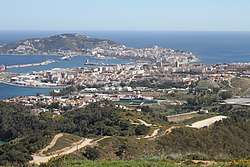 | |
.svg.png) Location of Ceuta within Spain | |
| Coordinates: 35°53′18″N 5°18′56″W | |
| Country | |
| Autonomous city | Ceuta |
| First settled | 1st millennium BC |
| End of Muslim rule | 14 August 1415 |
| Ceded to Spain | 1 January 1668 |
| Autonomy status | 14 March 1995 |
| Founded by | Carthaginians |
| Government | |
| • Type | Autonomous city |
| • Body | Council of Government |
| • Mayor-President | Juan Jesús Vivas (PP) |
| Area | |
| • Total | 18.5 km2 (7.1 sq mi) |
| • Land | 18.5 km2 (7.1 sq mi) |
| Elevation | 10 m (30 ft) |
| Highest elevation | 349 m (1,145 ft) |
| Population (2018)[1] | |
| • Total | 85,144 |
| • Density | 4,600/km2 (12,000/sq mi) |
| Demonyms | Ceutan ceutí (es) |
| Time zone | UTC+1 (CET) |
| • Summer (DST) | UTC+2 (CEST) |
| ISO 3166 code | ES-CE |
| Postal code | 51001–51005 |
| Official language | Spanish |
| Parliament | Cortes Generales |
| Congress | 1 deputy (out of 350) |
| Senate | 2 senators (out of 264) |
| Website | Ceuta.es |
Bordered by Morocco, it lies along the boundary between the Mediterranean Sea and the Atlantic Ocean and is one of nine populated Spanish territories in Africa and, along with Melilla, one of two populated Spanish territories on mainland Africa. It was part of province of Cádiz until 14 March 1995. On that date Statutes of Autonomy were passed for both Ceuta and Melilla.
Ceuta, like Melilla and the Canary Islands, was classified as a free port before Spain joined the European Union.[4] Its population consists of Christians, Muslims and small minorities of Sephardic Jews and ethnic Sindhi Hindus from modern-day Pakistan .
Spanish is the official language. Darija Arabic is also spoken by the 40–50% of the population who are of Moroccan origin.[5][6]
Names
The name Abyla has been said to have been a Punic name ("Lofty Mountain"[7] or "Mountain of God") for Jebel Musa,[8] the southern Pillar of Hercules.[9] The name of the mountain was in fact Habenna (Punic: 𐤀𐤁𐤍, ʾbn, "Stone" or "Stele") or ʾAbin-ḥīq (𐤀𐤁𐤍𐤇𐤒, ʾbnḥq, "Rock of the Bay"), in reference to the nearby Bay of Benzú.[10] The name was hellenized variously as Ápini (Greek: Ἄπινι),[10] Abýla (Ἀβύλα), Abýlē (Ἀβύλη), Ablýx (Ἀβλύξ), and Abílē Stḗlē (Ἀβίλη Στήλη, "Pillar of Abyla")[9] and in Latin as Mount Abyla (Abyla Mons) or the Pillar of Abyla (Abyla Columna).
The settlement below Jebel Musa was later renamed for the seven hills around the site, collectively referred to as the "Seven Brothers"[11] (Greek: Ἑπτάδελφοι, translit. Heptádelphoi;[12] Latin: Septem Fratres).[13] In particular, the Roman stronghold at the site took the name "Fort at the Seven Brothers" (Castellum ad Septem Fratres).[9] This was gradually shortened to Septem[14] (Σέπτον Sépton) or, occasionally, Septum[15] or Septa.[16] These clipped forms continued as Berber Sebta and Arabic Sabtan[11] or Sabtah (سبتة), which themselves became Ceuta in Portuguese (pronounced [ˈsewtɐ]) and Spanish (pronounced [ˈθewta]).
History
Ancient
.jpg)
Controlling access between the Atlantic Ocean and the Mediterranean Sea, the Strait of Gibraltar is an important military and commercial chokepoint. The Phoenicians realized the extremely narrow isthmus joining the Peninsula of Almina to the African mainland makes Ceuta eminently defensible and established an outpost there in the early 1st millennium BC. The Greek geographers record it by variations of Abyla, the ancient name of nearby Jebel Musa. Beside Calpe, the other Pillar of Hercules now known as the Rock of Gibraltar, the Phoenicians established Kart at what is now San Roque, Spain. Other good anchorages nearby became Phoenician and then Carthaginian ports at what are now Tangiers and Cadiz.
After Carthage's destruction in the Punic Wars, most of northwest Africa was left to the Roman client states of Numidia and—around Abyla—Mauretania. Punic culture continued to thrive in what the Romans knew as "Septem". After the Battle of Thapsus in 46 BC, Caesar and his heirs began annexing north Africa directly as Roman provinces but, as late as Augustus, most of Septem's Berber residents continued to speak and write in Punic.
Caligula assassinated the Mauretanian king Ptolemy in AD 40 and seized his kingdom, which Claudius organized in AD 42, placing Septem in the province of Tingitana and raising it to the level of a colony. It subsequently romanized and thrived into the late 3rd century, trading heavily with Roman Spain and becoming well known for its salted fish. Roads connected it overland with Tingis (Tangiers) and Volubilis. Under Theodosius I in the late 4th century, Septem still had 10,000 inhabitants, nearly all Christian citizens speaking Latin and African Romance.[17]
Medieval

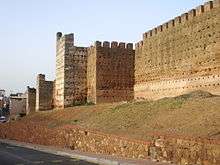
Vandals, probably invited by Count Boniface as protection against the empress dowager, crossed the strait near Tingis around 425 and swiftly overran Roman North Africa. Their king Gaiseric focused his attention on the rich lands around Carthage; although the Romans eventually accepted his conquests and he continued to raid them anyway, he soon lost control of Tingis and Septem in a series of Berber revolts. When Justinian decided to reconquer the Vandal lands, his victorious general Belisarius continued along the coast, making Septem an outpost of the Byzantine Empire around 533. Unlike the Roman administration, however, the Byzantines did not push far into hinterland and made the more defensible Septem their regional capital in place of Tingis.
Epidemics, less capable successors, and overstretched supply lines forced a retrenchment and left Septem isolated. It is likely that its count (comes) was obliged to pay homage to the Visigoth Kingdom in Spain in the early 7th century. There are no reliable contemporary accounts of the end of the Islamic conquest of the Maghreb around 710. Instead, the rapid Muslim conquest of Spain produced romances concerning Count Julian of Septem and his betrayal of Christendom in revenge for the dishonor that befell his daughter at King Roderick's court. Allegedly with Julian's encouragement and instructions, the Berber convert and freedman Tariq ibn Ziyad took his garrison from Tangiers across the strait and overran the Spanish so swiftly that both he and his master Musa bin Nusayr fell afoul of a jealous caliph, who stripped them of their wealth and titles.
After the death of Julian, sometimes also described as a king of the Ghomara Berbers, Berber converts to Islam took direct control of what they called Sebta. It was then destroyed during their great revolt against the Umayyad Caliphate around 740. Sebta subsequently remained a small village of Muslims and Christians surrounded by ruins until its resettlement in the 9th century by Mâjakas, chief of the Majkasa Berber tribe, who started the short-lived Banu Isam dynasty.[18] His great-grandson briefly allied his tribe with the Idrisids, but Banu Isam rule ended in 931 when he abdicated in favor of Abd ar-Rahman III, the Umayyad caliph of Cordoba. Ceuta reverted to Moorish Andalusian rule in 927 along with Melilla, and later Tangier, in 951.
Chaos ensued with the fall of the Spanish Umayyads in 1031. Following this, Ceuta and Muslim Iberia were controlled by successive North African dynasties. Starting in 1084, the Almoravid Berbers ruled the region until 1147, when the Almohads conquered the land. Apart from Ibn Hud's rebellion in 1232, they ruled until the Tunisian Hafsids established control. The Hafsids' influence in the west rapidly waned, and Ceuta's inhabitants eventually expelled them in 1249. After this, a period of political instability persisted, under competing interests from the kingdoms of Fez and Granada as well as autonomous rule under the native Banu al-Azafi. The Fez finally conquered the region in 1387, with assistance from Aragon.
Portuguese
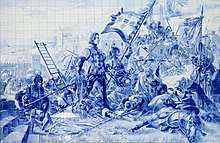
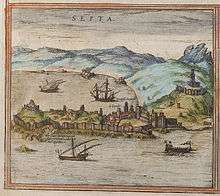

On the morning of 21 August 1415, King John I of Portugal led his sons and their assembled forces in a surprise assault that would come to be known as the Conquest of Ceuta. The battle was almost anti-climactic, because the 45,000 men who traveled on 200 Portuguese ships caught the defenders of Ceuta off guard and only suffered eight casualties. By nightfall the town was captured. On the morning of August 22, Ceuta was in Portuguese hands. Álvaro Vaz de Almada, 1st Count of Avranches was asked to hoist what was to become the flag of Ceuta, which is identical to the flag of Lisbon, but in which the coat of arms of the Kingdom of Portugal was added to the center; the original Portuguese flag and coat of arms of Ceuta remained unchanged, and the modern-day Ceuta flag features the configuration of the Portuguese shield.
John's son Henry the Navigator distinguished himself in the battle, being wounded during the conquest. The looting of the city proved to be less profitable than expected for John I; he decided to keep the city to pursue further enterprises in the area.[19]
From 1415 to 1437, Pedro de Meneses became the first governor of Ceuta.
The Benemerine sultan started the 1418 siege but was defeated by the first governor of Ceuta before reinforcements arrived in the form of John, Constable of Portugal and his brother Henry the Navigator who were sent with troops to defend Ceuta.
Under King John I's son, Duarte, the colony at Ceuta rapidly became a drain on the Portuguese treasury. Trans-Saharan trade journeyed instead to Tangier. It was soon realized that without the city of Tangier, possession of Ceuta was worthless. In 1437, Duarte's brothers Henry the Navigator and Fernando, the Saint Prince persuaded him to launch an attack on the Marinid sultanate. The resulting Battle of Tangier (1437), led by Henry, was a debacle. In the resulting treaty, Henry promised to deliver Ceuta back to the Marinids in return for allowing the Portuguese army to depart unmolested, which he reneged on.
Possession of Ceuta would indirectly lead to further Portuguese expansion. The main area of Portuguese expansion, at this time, was the coast of the Maghreb, where there was grain, cattle, sugar, and textiles, as well as fish, hides, wax, and honey.[20]
Ceuta had to endure alone for 43 years, until the position of the city was consolidated with the taking of Ksar es-Seghir (1458), Arzila and Tangier (1471) by the Portuguese.
The city was recognized as a Portuguese possession by the Treaty of Alcáçovas (1479) and by the Treaty of Tordesilhas (1494).
In the 1540s the Portuguese began building the Royal Walls of Ceuta as they are today including bastions, a navigable moat and a drawbridge. Some of these bastions are still standing, like the bastions of Coraza Alta, Bandera and Mallorquines.[21]
Luís de Camões lived in Ceuta between 1549 and 1551, losing his right eye in battle, which influenced his work of poetry Os Lusíadas.
Iberian Union
In 1578 King Sebastian of Portugal died at the Battle of Alcácer Quibir (known as the Battle of Three Kings) in what is today northern Morocco, without descendants, triggering the 1580 Portuguese succession crisis. His granduncle, the elderly Cardinal Henry, succeeded him as King, but Henry also had no descendants, having taken holy orders. When the cardinal-king died two years after Sebastian's disappearance, three grandchildren of King Manuel I of Portugal claimed the throne: Infanta Catarina, Duchess of Braganza, António, Prior of Crato, and Philip II of Spain (Uncle of former King Sebastian of Portugal), who would go on to be crowned King Philip I of Portugal in 1581, uniting the two crowns and overseas empires known as the Iberian Union,[22] which allowed the two kingdoms to continue without being merged.
During the Iberian Union 1580 to 1640, Ceuta attracted many residents of Spanish origin.[23] Ceuta became the only city of the Portuguese Empire that sided with Spain when Portugal regained its independence in the Portuguese Restoration War of 1640.
Spanish
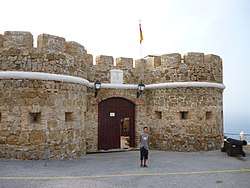

On 1 January 1668, King Afonso VI of Portugal recognized the formal allegiance of Ceuta to Spain and formally ceded Ceuta to King Carlos II of Spain by the Treaty of Lisbon.
The city was attacked by Moroccan forces under Moulay Ismail during the Siege of Ceuta (1694-1727). During the longest siege in history, the city underwent changes leading to the loss of its Portuguese character. While most of the military operations took place around the Royal Walls of Ceuta, there were also small-scale penetrations by Spanish forces at various points on the Moroccan coast, and seizure of shipping in the Strait of Gibraltar.
Disagreements regarding the border of Ceuta resulted in the Hispano-Moroccan War (1859–60), which ended at the Battle of Tetuán.

In July 1936, General Francisco Franco took command of the Spanish Army of Africa and rebelled against the Spanish republican government; his military uprising led to the Spanish Civil War of 1936–1939. Franco transported troops to mainland Spain in an airlift using transport aircraft supplied by Germany and Italy. Ceuta became one of the first casualties of the uprising: General Franco's rebel nationalist forces seized Ceuta, while at the same time the city came under fire from the air and sea forces of the official republican government.[24]
The Llano Amarillo monument was erected to honor Francisco Franco, it was inaugurated on 13 July 1940. The tall obelisk has since been abandoned, but the shield symbols of the Falange and Imperial Eagle remain visible.[25]
When Spain recognized the independence of Spanish Morocco in 1956, Ceuta and the other plazas de soberanía remained under Spanish rule. Spain considered them integral parts of the Spanish state, but Morocco has disputed this point.
Culturally, modern Ceuta is part of the Spanish region of Andalusia. It was attached to the province of Cádiz until 1925, the Spanish coast being only 20 km (12.5 miles) away. It is a cosmopolitan city, with a large ethnic Arab-Berber Muslim minority as well as Sephardic Jewish and Hindu minorities.[26]
On 5 November 2007, King Juan Carlos I visited the city, sparking great enthusiasm from the local population and protests from the Moroccan government.[27] It was the first time a Spanish head of state had visited Ceuta in 80 years.
Since 2010, Ceuta (and Melilla) have declared the Muslim holiday of Eid al-Adha, or Feast of the Sacrifice, an official public holiday. It is the first time a non-Christian religious festival has been officially celebrated in Spain since the Reconquista.[28][29]
Geography
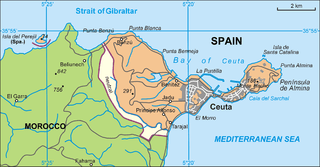
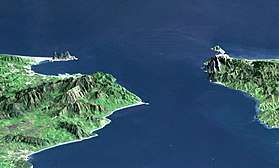
It is separated by 17 km (11 mi)[30] from the province of Cádiz on the Spanish mainland by the Strait of Gibraltar and it shares a 6.4 km (4 mi) land border with M'diq-Fnideq Prefecture in the Kingdom of Morocco.
It has an area of 18.5 km2 (7 sq mi; 4,571 acres).
Ceuta is dominated by Monte Anyera, a hill along its western frontier with Morocco. The mountain is guarded by a military fort.
Monte Hacho on the Peninsula of Almina overlooking the port is one of the possible locations for the southern pillar of the Pillars of Hercules of Greek legend (the other possibility being Jebel Musa).[31]
Climate
Ceuta has a maritime-influenced Subtropical/Mediterranean climate, similar to nearby Spanish and Moroccan cities such as Tarifa, Algeciras or Tangiers.[32] The average diurnal temperature variation is relatively low; the average annual temperature is 18.8 °C (65.8 °F) with average yearly highs of 21.4 °C (70.5 °F) and lows of 15.7 °C (60.3 °F) though the Ceuta weather station has only been in operation since 2003.[33] Ceuta has relatively mild winters for the latitude, while summers are warm yet milder than in the interior of Southern Spain, due to the moderating effect of the Straits of Gibraltar. Summers are very dry, but yearly precipitation is still at 849 mm (33.4 in),[33] which could be considered a humid climate if the summers were not so arid.
| Climate data for Ceuta city (1m altitude) | |||||||||||||
|---|---|---|---|---|---|---|---|---|---|---|---|---|---|
| Month | Jan | Feb | Mar | Apr | May | Jun | Jul | Aug | Sep | Oct | Nov | Dec | Year |
| Record high °C (°F) | 21.7 (71.1) |
25.5 (77.9) |
27.9 (82.2) |
28.4 (83.1) |
33.7 (92.7) |
35.3 (95.5) |
40.2 (104.4) |
38.9 (102.0) |
34.8 (94.6) |
33.1 (91.6) |
27.2 (81.0) |
25.6 (78.1) |
40.2 (104.4) |
| Average high °C (°F) | 16.1 (61.0) |
16.7 (62.1) |
17.8 (64.0) |
19.4 (66.9) |
22.5 (72.5) |
25.8 (78.4) |
28.9 (84.0) |
28.5 (83.3) |
26.1 (79.0) |
22.9 (73.2) |
18.9 (66.0) |
16.7 (62.1) |
21.7 (71.1) |
| Daily mean °C (°F) | 13.6 (56.5) |
14.2 (57.6) |
15.0 (59.0) |
16.5 (61.7) |
19.2 (66.6) |
22.3 (72.1) |
25.0 (77.0) |
25.1 (77.2) |
23.0 (73.4) |
20.2 (68.4) |
16.5 (61.7) |
14.4 (57.9) |
18.8 (65.8) |
| Average low °C (°F) | 11.1 (52.0) |
11.6 (52.9) |
12.2 (54.0) |
13.6 (56.5) |
15.9 (60.6) |
18.8 (65.8) |
21.1 (70.0) |
21.7 (71.1) |
19.9 (67.8) |
17.5 (63.5) |
14.0 (57.2) |
12.2 (54.0) |
15.8 (60.4) |
| Record low °C (°F) | 1.3 (34.3) |
4.4 (39.9) |
7.2 (45.0) |
9.0 (48.2) |
10.5 (50.9) |
13.2 (55.8) |
16.3 (61.3) |
18.0 (64.4) |
15.3 (59.5) |
12.2 (54.0) |
7.4 (45.3) |
6.3 (43.3) |
1.3 (34.3) |
| Average precipitation mm (inches) | 122 (4.8) |
145 (5.7) |
90 (3.5) |
57 (2.2) |
21 (0.8) |
3 (0.1) |
1 (0.0) |
3 (0.1) |
37 (1.5) |
82 (3.2) |
127 (5.0) |
161 (6.3) |
849 (33.2) |
| Average precipitation days | 7 | 8 | 6 | 5 | 3 | 1 | 0 | 1 | 2 | 5 | 7 | 9 | 54 |
| Average relative humidity (%) | 72 | 75 | 68 | 71 | 66 | 67 | 61 | 70 | 72 | 75 | 73 | 73 | 70 |
| Source: Weather.com,[34] WorldWeatherOnline,[35][33] and Agencia Estatal de Meteorología[36] | |||||||||||||
Politics
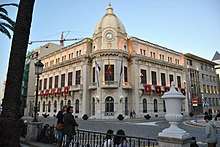
Since 1995, Ceuta is, along with Melilla, one of the two autonomous cities of Spain.[37]
Ceuta is known officially in Spanish as Ciudad Autónoma de Ceuta (English: Autonomous City of Ceuta), with a rank between a standard Spanish city and an autonomous community. Ceuta is part of the territory of the European Union. The city was a free port before Spain joined the European Union in 1986. Now it has a low-tax system within the Economic and Monetary Union of the European Union. As of 2018, its population was 85,144.[38]
Ceuta has held elections every four years since 1979, for its 25-seat assembly. The leader of its government was the Mayor until the Autonomy Statute had the title changed to the Mayor-President. As of 2011, the People's Party (PP) won 18 seats, keeping Juan Jesús Vivas as Mayor-President, which he has been since 2001. The remaining seats are held by the regionalist Caballas Coalition (4) and the Socialist Workers' Party (PSOE, 3).[39]
Due to its small population, Ceuta elects only one member of the Congress of Deputies, the lower house of the Spanish legislature. As of the November 2019 election, this post is held by María Teresa López of Vox.[40]
Subdivisions
Ceuta is subdivided into 63 barriadas ("neighborhoods"), such as Barriada de Berizu, Barriada de P. Alfonso, Barriada del Sarchal, and El Hacho.[41][42][43]
Dispute with Morocco
The government of Morocco has repeatedly called for Spain to transfer the sovereignty of Ceuta and Melilla, along with uninhabited islets such as the islands of Alhucemas, Velez and the Perejil island, drawing comparisons with Spain's territorial claim to Gibraltar. In both cases, the national governments and local populations of the disputed territories reject these claims by a large majority.[44] The Spanish position states that both Ceuta and Melilla are integral parts of Spain, and have been since the 16th century, centuries prior to Morocco's independence from France in 1956, whereas Gibraltar, being a British Overseas Territory, is not and never has been part of the United Kingdom.[45] Morocco has claimed the territories are colonies.[46] One of the chief arguments used by Morocco to reclaim Ceuta comes from geography, as this enclave, which is surrounded by Morocco and the Mediterranean Sea, has no territorial continuity with the rest of Spanish territory.[47] This argument was originally developed by one of the founders of the Moroccan Istiqlal Party, Alal-El Faasi, who openly advocated the Moroccan conquest of Ceuta and other territories under Spanish rule.[48]
Economy
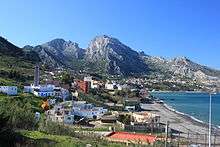

The official currency of Ceuta is the euro. It is part of a special low tax zone in Spain.[49] Ceuta is one of two Spanish port cities on the northern shore of Africa, along with Melilla. They are historically military strongholds, free ports, oil ports, and also fishing ports.[50] Today the economy of the city depends heavily on its port (now in expansion) and its industrial and retail centers.[49] Ceuta Heliport is now used to connect the city to mainland Spain by air. Lidl, Decathlon and El Corte Inglés (hardware) have branches in Ceuta. There is also a casino. Border trade between Ceuta and Morocco is active because of advantage of tax-free status. Thousands of Moroccan women are involved in porter trade daily. Moroccan dirham is actually used in such trade, despite the fact that prices are marked in euro.[51][52][53]
Transport
The city's Port of Ceuta receives high numbers of ferries each day from Algeciras in Andalusia in the south of Spain, along with Melilla and the Canary Islands. The closest airport is Sania Ramel Airport in Morocco.
A single road border checkpoint to the south of Ceuta near Fnideq allows for cars and pedestrians to travel between Morocco and Ceuta. An additional border crossing for pedestrians also exists between Benzú and Belyounech on the northern coast. The rest of the border is closed and inaccessible.
There is a bus service throughout the city, and while it does not pass into neighboring Morocco, it services both frontier crossings.
Demographics
Due to its location, Ceuta is home to a mixed ethnic and religious population. The two main religious groups are Christians and Muslims. As of 2006 approximately 50% of the population was Christian and approximately 48% Muslim.[59] However, by 2012, the portion of Ceuta's population that identify as Roman Catholic was 68.0%, while the portion of Ceuta's population that identify as Muslim was 28.3%.[60]
Spanish is the primary and official language of the enclave.[61] Moroccan Arabic is widely spoken,[62] as are Berber and French.[63]
Religion
Christianity has been present in Ceuta continuously from late antiquity, as evidenced by the ruins of a basilica in downtown Ceuta[64] and accounts of the martyrdom of St. Daniel Fasanella and his Franciscans in 1227 during the Almohad Caliphate.
The town's Grand Mosque had been built over a Byzantine-era church. In 1415, the year of the city's conquest, the Portuguese converted the Grand Mosque into Ceuta Cathedral. The present form of the cathedral dates to refurbishments undertaken in the late 17th century, combining baroque and neoclassical elements. It was dedicated to St Mary of the Assumption in 1726.
The Roman Catholic Diocese of Ceuta was established in 1417. It incorporated the suppressed Diocese of Tanger in 1570.[65] The Diocese of Ceuta was a suffragan of Lisbon until 1675, when it became a suffragan of Seville.[66] In 1851, Ceuta's administration was notionally merged into the Diocese of Cadiz and Ceuta as part of a concordat between Spain and the Holy See;[67] the union was not actually accomplished, however, until 1879.
Small Jewish and Hindu minorities are also present in the city.[68]
Education
The University of Granada offers undergraduate programs at their campus in Ceuta. Like all areas of Spain, Ceuta is also served by the National University of Distance Education (UNED).
Primary and secondary education is possible only in Spanish however a growing number of schools are entering the Bilingual Education Program.
Migrants
Like Melilla, Ceuta attracts African migrants who try to use it as an entry to Europe. As a result, the enclave is surrounded by double fences that are 6 m (20 ft) high and hundreds of migrants congregate near the fences waiting for a chance to cross them. The fences are regularly stormed by migrants trying to claim asylum once they enter Ceuta.[69]
Notable people from Ceuta
1083 to 1700
- Qadi Ayyad (1083 in Ceuta – 1149) born in Ceuta, then belonging to the Almoravids was the great imam of that city
- Al-Idrisi (1100 in Ceuta – 1165 in Ceuta) was a Muslim geographer, cartographer and Egyptologist. He lived in Palermo at the court of King Roger II of Sicily, known for the "Tabula Rogeriana"
- Abu al-Abbas as-Sabti (1129 in Ceuta – 1204 in Marrakesh) is the patron saint of Marrakesh
- Joseph ben Judah of Ceuta (c. 1160 – 1226) was a Jewish physician and poet, and disciple of Moses Maimonides
- Abu al-Abbas al-Azafi (1162 in Ceuta – 1236) a religious and legal scholar, member of the Banu al-Azafi who ruled Ceuta
- Mohammed ibn Rushayd (1259 in Sabta – 1321) was a judge, writer and scholar of Hadith
- Álvaro of Braganza (1440–1504) was a president of Council of Castile.
1700 to 1800
- George Camocke (1666–1732) was a Royal Navy captain and former admiral for Spain who was exiled to Ceuta to live out the last years of his life.
- Don Fernando de Leyba (1734 in Ceuta – 1780) was a Spanish officer who served as the third governor of Upper Louisiana from 1778 until his death.
- Brigadier General Francisco Antonio García Carrasco Díaz (1742 in Ceuta – 1813 in Lima, Peru ) was a Spanish soldier and Royal Governor of Chile
- Sebastián Kindelán y O'Regan (1757 in Ceuta – 1826 in Santiago de Cuba) was a colonel in the Spanish Army who served as governor of East Florida 1812/1815, of Santo Domingo 1818/1821 and was provisional governor of Cuba 1822/1823
- Isidro de Alaix Fábregas Count of Vergara and Viscount of Villarrobledo, (1790 in Ceuta – 1853 in Madrid) was a Spanish general of the First Carlist War who backed Isabella II of Spain
1800 to 1950
- General Francisco Llano de la Encomienda (1879 in Ceuta – 1963 in Mexico City) was a Spanish soldier. During the Spanish Civil War (1936–1939) he remained loyal to the Second Spanish Republic
- General Antonio Escobar Huertas (1879 in Ceuta – executed 1940 in Barcelona) was a Spanish military officer
- África de las Heras Gavilán (1909 in Ceuta – 1988 in Moscow) was a Spanish Communist, naturalized Soviet citizen, and KGB spy who went by the code name Patria
- Eugenio Martín (born 1925 in Ceuta) is a Spanish film director and screenwriter
- Jacob Hassan, PhD (1936 in Ceuta – 2006 in Madrid) was a Spanish-Jewish philologist
- José Martínez Sánchez (born 1945 in Ceuta), nicknamed Pirri, is a retired Spanish footballer, mainly played for Real Madrid, appearing in 561 competitive games and scoring 172 goals
- Manuel Chaves González (born 1945 in Ceuta) is a Spanish politician of the Spanish Socialist Workers' Party. He served as the Third Vice President of the Spanish Government from 2009 to 2011
- Ramón Castellano de Torres (born 1947 in Ceuta) is a Spanish artist, thought by some to be an expressionist painter
- José Ramón López (born 1950) was a sprint canoer. He won the silver medal in the 1976 Summer Olympics.
1950 to date
- Miguel Bernardo Bianquetti (born 1951 in Ceuta), known as Migueli is a Spanish retired footballer who played central defender.
- Francisco Lesmes and Rafael Lesmes Bobed brothers and Spanish footballers.
- Ignacio Velázquez Rivera (born 1953), first Mayor-President of Melilla
- Juan Jesús Vivas Lara (born 1953 in Ceuta) became the Mayor-President of Ceuta in Spain in 2001
- Pedro Aviles Gutiérrez (born 1956 in Ceuta) is a Spanish novelist from Madrid.
- Nayim (born 1966 in Ceuta) is a retired Spanish footballer; he scored a last-minute goal for Real Zaragoza in the 1995 UEFA Cup Winners' Cup Final.
- Eva María Isanta Foncuberta (born 1971 in Ceuta) is a Spanish actress [70]
- Mohamed Taieb Ahmed (born 1975 in Ceuta) is a Spanish-Moroccan drug lord [71] responsible for trafficking hashish across the Strait of Gibraltar and into Spain.
- Lorena Miranda (born 1991 in Ceuta) is a Spanish female water polo player. She won a silver medal playing for the Spanish team in the 2012 Summer Olympics.
- Anuar Tuhami (born 1995 in Ceuta) is a Spanish-Moroccan footballer.
Twin towns and sister cities
Ceuta is twinned with:
See also
- AD Ceuta FC, football club
- Arab Baths in Ceuta
- Benzú
- Hotel Tryp Ceuta
- Ceuta border fence
- Ceuta and Melilla (disambiguation)
- Plazas de soberanía – Spanish exclaves on the Moroccan coast
- Porteadoras – mule ladies, bale workers
- Royal Walls of Ceuta
- Spanish Morocco
- European enclaves in North Africa before 1830
References
Citations
- Municipal Register of Spain 2018. National Statistics Institute.
- Wells, John C. (2008). Longman Pronunciation Dictionary (3rd ed.). Longman. ISBN 978-1-4058-8118-0.
- Jones, Daniel (2011). Roach, Peter; Setter, Jane; Esling, John (eds.). Cambridge English Pronouncing Dictionary (18th ed.). Cambridge University Press. ISBN 978-0-521-15255-6.
- Ferrer-Gallardo, Xavier (2008). "The Spanish–Moroccan border complex: Processes of geopolitical, functional and symbolic rebordering". Political Geography. 27 (3): 301–321. doi:10.1016/j.polgeo.2007.12.004.
- Verónica Rivera (December 2006). "IMPORTANCIA Y VALORACIÓN SOCIOLINGÜÍSTICA DEL DARIJA EN EL CONTEXTO DE LA EDUCACIÓN SECUNDARIA PÚBLICA EN CEUTA" [Importance and Socio-Linguistic Valuation of Darija in the Context of Public Secondary Education in Ceuta]. Revista Electrónica de Estudios Filológicos (in Spanish) (12). ISSN 1577-6921.
- Fernández García, Alicia (2016). "Nacionalismo y representaciones lingüísticas en Ceuta y en Melilla". Revista de Filología Románica. Madrid: Universidad Complutense de Madrid. 33 (1): 23–46. doi:10.5209/RFRM.55230. ISSN 0212-999X.
- Cauvin & al. (1843).
- Bonney & al. (1907), p. 26.
- Smith (1854).
- Lipiński (2004), p. 422–425.
- Smedley & al. (1845), p. 49.
- Ptolemy, Geography, IV.i.5.
- In, e.g., Pomponius Mela.
- Walter E. Kaegi (4 November 2010). Muslim Expansion and Byzantine Collapse in North Africa. Cambridge University Press. p. 256. ISBN 978-0-521-19677-2.
- A Cyclopædia of Biblical Literature. 2. John Kitto, William Lindsay Alexander. 1864. p. 350.CS1 maint: others (link)
- Dyer (1873).
- Mommsen, Theodore, The Provinces of the Roman Empire, s.v. "Africa".
- Gibb, Hamilton Alexander Rosskeen; Johannes Hendrik Kramers; Bernard Lewis; Charles Pellat; Joseph Schacht (1994), The Encyclopaedia of Islam, E.J. Brill, p. 690.
- López de Coca Castañer, José Enrique (1998). "Granada y la expansión portuguesa en el Magreb extremo". Historia. Instituciones. Documentos. Seville: Universidad de Sevilla (25): 351. ISSN 0210-7716.
- Payne, Stanley G., A History of Spain and Portugal, Vol.1, Chap.10 "The Expansion"
- "Ceuta". fortified-places.com. Retrieved 17 September 2015.
-
- Kamen, Henry (1999). Philip of Spain. Yale University Press. p. 177. ISBN 9780300078008.
- Griffin, H (2010). Ceuta Mini Guide. Mirage. ISBN 978-0-9543335-3-9. Archived from the original on 5 March 2012. Retrieved 18 January 2010.
- "History of Ceuta". Archived from the original on 5 March 2012. Retrieved 1 March 2012.
- "Franco monument now part of a rubbish dump in Ceuta". Archived from the original on 7 December 2012.
- "Resistir en el monte del Renegado". El País. 22 March 2009. Retrieved 17 June 2009.
- "Ceuta y Melilla son España, dice Juan Carlos I; Sebta y Melilia son nuestras, responde Mohamed VI". Blogs.periodistadigital.com. 22 February 1999. Archived from the original on 18 July 2011. Retrieved 17 June 2009.
- "Muslim Holiday in Ceuta and Melilla". Spainforvisitors.com. Archived from the original on 29 September 2011. Retrieved 3 September 2011.
- "Public Holidays and Bank Holidays for Spain". Qppstudio.net. Archived from the original on 30 September 2011. Retrieved 3 September 2011.
- "Turismo. Ceuta, cuatro mundos por descubrir". abcViajes. Retrieved 1 February 2020.
- H. Micheal Tarver; Emily Slape, eds. (25 July 2016). The Spanish Empire: A Historical Encyclopedia. I. ABC-CLIO. p. 160. ISBN 978-1-61069-422-3.
- "Ceuta, Spain — Climate Summary". weatherbase. Retrieved 8 December 2014.
- "Valores climatológicos normales. Ceuta" [Normal climate values. Ceuta]. AEMET (in Spanish). Agencia Estatal de Meteorología. Retrieved 11 August 2015.
- "Monthly Averages for Ceuta, Spain". Weather.com. Archived from the original on 20 October 2012. Retrieved 16 August 2016.
- "Ceuta Monthly Climate Averages". World Weather Online. Retrieved 16 August 2016.
- "Valores extremos. Ceuta — Selector" [Extreme values. Ceuta – Selector]. AEMET (in Spanish). Agencia Estatal de Meteorología. Retrieved 16 August 2016.
- "Ley Orgánica 1/1995, de 13 de marzo, Estatuto de Autonomía de Ceuta" (in Spanish). Noticias.juridicas.com. Retrieved 17 June 2009.
- "La población de Ceuta aumenta en un 0,2% con respecto a 2017". El Faro de Ceuta. Retrieved 8 May 2019.
- "Resultados Electorales en Ceuta: Elecciones Municipales 2011 en EL PAÍS" (in Spanish). EDICIONES EL PAÍS S.L. 2011. Retrieved 16 August 2016.
- "Ceuta Votes for Far-Right Vox Party in Spanish General Elections". Morocco World News. 11 November 2019. Retrieved 28 January 2020.
- "El servicio de Policia de Barriadas podria funcionar a partir del 15 de septiembre" [The Police Service of Barriadas could work from September 15]. El Pueblo de Ceuta (in Spanish). Archived from the original on 20 July 2011. Retrieved 17 June 2009.
- "Map of Ceuta". planetware.
- "Códigos postales de Ceuta en Ceuta". Codigo-postal.info. Retrieved 17 June 2009.
-
- François Papet-Périn, "La mer d'Alboran ou Le contentieux territorial hispano-marocain sur les deux bornes européennes de Ceuta et Melilla". Tome 1, 794 p., tome 2, 308 p., thèse de doctorat d'histoire contemporaine soutenue en 2012 à Paris 1-Sorbonne sous la direction de Pierre Vermeren.
- Tremlett, Giles (12 June 2003). "A rocky relationship | World news | guardian.co.uk". London: Guardian. Retrieved 17 June 2009.
- Gold, Peter (2000). Europe or Africa? A contemporary study of the Spanish North African enclaves of Ceuta and Melilla. Liverpool University Press. pp. XII–XIII. ISBN 0-85323-985-1.
- Castan Pinos, J. (2014) ‘The Spanish-Moroccan relationship: combining bonne entente with territorial disputes’, in K. Stoklosa (ed.) Living on the border. European Border Regions in Comparison (p. 103). Abingdon: Routledge.
- Castan Pinos, J. (2014) La Fortaleza Europea: Schengen, Ceuta y Melilla. Ceuta: Instituto de Estudios Ceutíes, p. 61 ISBN 978-84-92627-67-7
- "Economic Data of Ceuta, de ceutna digital". Ceuta.es. Archived from the original on 10 April 2010. Retrieved 17 June 2009.
- O'Reilly, Gerry; O'Reilly, J. G. (1994). IBRU, Boundary and Territory Briefing. Ceuta and the Spanish Sovereign Territories: Spanish and Moroccan. pp. 6–7. ISBN 9781897643068. Retrieved 17 June 2009.
- "Morocco 'mule women' in back-breaking trade from Spain enclave". 6 October 2017. Retrieved 11 May 2018.
- "The economics of exclaves". 24 April 2018. Retrieved 11 May 2018.
- (www.dw.com), Deutsche Welle. "Moroccan women used as 'mules' to avoid tariffs | DW | 11.05.2018". DW.COM. Retrieved 11 May 2018.
- Google Maps
- "Hospitals in Ceuta". Hospitals Worldguide. Retrieved 8 July 2020.
- "Hospital Universitario de Ceuta". Retrieved 8 July 2020.
- "Port Directory of Principal Foreign Ports". Google Books. 1929. Retrieved 8 July 2020.
- "Military Medicine in Spain". Military Medicine. Retrieved 8 July 2020.
- Roa, J. M. (2006). "Scholastic achievement and the diglossic situation in a sample of primary-school students in Ceuta". Revista Electrónica de Investigación Educativa. 8 (1).
- "Interactivo: Creencias y prácticas religiosas en España". lavanguardia.com. Retrieved 10 September 2017.
- "Languages Across Europe – Spanish". BBC. 14 October 2014. Archived from the original on 5 April 2018.
- Sayahi, Lotfi (2011). "Spanish in Contact with Arabic". In Díaz-Campos, Manuel (ed.). The Handbook of Hispanic Sociolinguistics. Chichester, UK: Blackwell Publishing. pp. 476–477. doi:10.1002/9781444393446.ch22. ISBN 978-1-4051-9500-3.
- Roa-Venegas, José María (2006). "Scholastic Achievement and the Diglossic Situation in a Sample of Primary-School Students in Ceuta". Revista Electrónica de Investigación Educativa. 8 (1): 3, 12 – via ResearchGate.
- Villada, Fernando. "Ceuta huellas del cristianismo en Ceuta". academia.edu. Retrieved 10 September 2017.
- "Catholic Encyclopedia: Tingis". Newadvent.org. 1 July 1912. Retrieved 8 August 2010.
- "Diocese of Ceuta". Catholic-Hierarchy.org. David M. Cheney. Retrieved 21 January 2015. [self-published]
- "Catholic Encyclopedia: Cadiz". Newadvent.org. 1 November 1908. Retrieved 8 August 2010.
- "Ceuta: Multicultural city". www.aljazeera.com. Retrieved 28 April 2020.
- "Hundreds of migrants storm fence to reach Spanish enclave of Ceuta". BBC. 17 February 2017.
- IMDb retrieved 19 October 2017
- "Vuelve 'El Nene'". Interviu (in Spanish). 14 January 2008. Retrieved 20 October 2017.
- "Listado de corporaciones locales españolas hermanadas con Europa" (PDF). Spanish Federation of Municipalities and Provinces.
- Corrales, Carlos (5 August 2012). "Ceuta y Algeciras, tres lustros como ciudades hermanadas". Europa Sur.
- Durio, Pablo Manuel (19 September 2009). "Cádiz tiene ya una familia más que numerosa". Diario de Cádiz.
- Parodi, Luis (27 November 2007). "Vivas visitará el jueves la Casa de Ceuta en Cádiz antes de regresar". El Pueblo de Ceuta.
Bibliography
- Bonney, Thomas George; et al. (1907), The Mediterranean: Its Storied Cities and Venerable Ruins, New York: James Pott & Co.
- Cauvin, Joseph; et al., eds. (1843), "Abila", Lempriere's Classical Dictionary..., London: Longman, Brown, Green, & Longmans.
- Dyer, Thomas H. (1873), "Septem Fratres", A Dictionary of Greek and Roman Geography..., II, London: John Murray, p. 965.
- Lipiński, Edward (2004), Itineraria Phoenicia, Orientalia Lovaniensia Analecta, No. 127, Studia Phoenicia, Vol. XVIII, Leuven: Uitgeverij Peeters, ISBN 9789042913448.
- Smedley, Edward; et al., eds. (1845), "Mauritania", Encyclopaedia Metropolitana..., XXII, London: B. Fellowes & al., pp. 48–49.
- Smith, Philip (1854), "Abyla", Dictionary of Greek and Roman Geography..., London: Walton & Maberly.
External links
| Wikimedia Commons has media related to Ceuta. |
| Wikivoyage has a travel guide for Ceuta. |
- . Encyclopædia Britannica (11th ed.). 1911.
- (in Spanish) Official Ceuta government website
- Ceuta tourism website
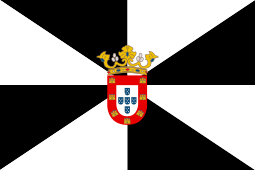




%2C_Algeria_04966r.jpg)